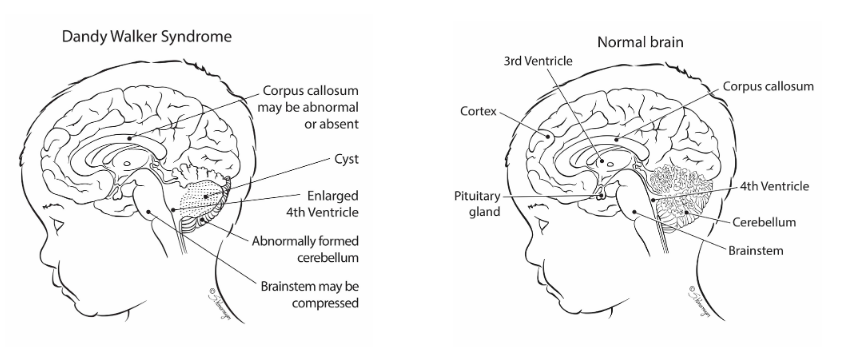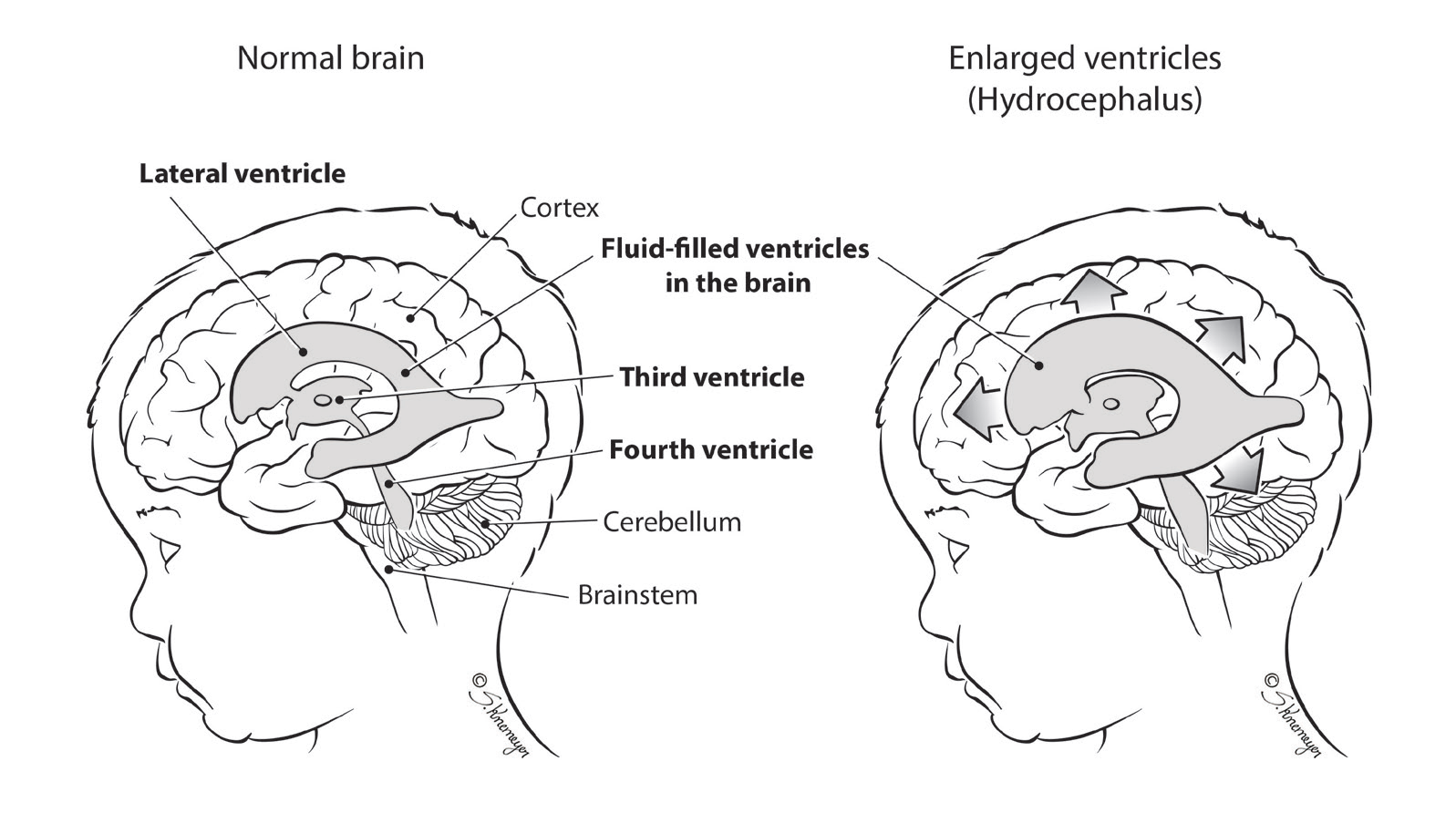Dandy-Walker Syndrome
Dandy-Walker Syndrome (DWS) is a congenital condition where the cerebellum does not develop normally.
What Is Dandy-Walker Syndrome?
Dandy-Walker Syndrome (DWS) is a congenital (happening before birth) condition where the cerebellum does not develop normally. The cerebellum is an area at the back of the brain that controls movement and balance.
With DWS, parts of the cerebellum may never develop or may be very small. Other parts of the cerebellum become filled with fluid or develop small masses of fluid (cysts). In most cases, a build-up of fluid inside the skull causes the head to get bigger than it should.
DWS can occur by itself, or along with other types of birth defects. Children with DWS may also have heart problems, face or limb defects or problems with vison and hearing. In rare cases, DWS may not be diagnosed until late childhood or adulthood. DWS can cause delays in both motor and mental development. The severity of symptoms and long-term outcomes are different for each child. Some children need a lot of medical care at birth but go on to live normal lives with few or no long-term effects. Other children may lose the ability to move parts of their body (paralysis), seizures and problems with thinking and learning.
The long-term survival rate for infants with isolated DWS is very good. If DWS appears with other genetic conditions, outcomes can vary. Early treatment to support physical and mental development improves a child’s chances of having the best quality of life possible for their condition.

What Causes Dandy-Walker Syndrome?
No one is sure what causes DWS. Scientists do know that certain genetic conditions or other outside factors may increase the risk of a baby having the disease.
DWS begins during the first month of pregnancy. As the baby’s cerebellum starts to develop abnormally, fluid begins to build up. During the pregnancy, malformations and fluid in the cerebellum continue to grow. The fluid build-up and problems in the brain structure can cause many neurological and physical symptoms seen at birth and later in childhood.
No one knows what causes DWS. There are likely many factors that could be a part of its development. A number of different genetic syndromes are associated with DWS. Certain medical problems in the mother, such as diabetes, have been associated with the development of DWS. There is some research that says a baby’s risk for developing DWS increases if the mother is exposed to certain types of infections or medicines while she is pregnant.
How Is Dandy-Walker Syndrome Diagnosed?
A variety of prenatal (before birth) tests can help your doctor diagnose DWS:
- Ultrasound: This type of imaging test that can show problems with how your baby’s brain is forming
- Fetal MRI (magnetic resonance imaging): Non-invasive imaging test to get a clear, more detailed image of your baby’s organs.
Other Tests
Some congenital conditions are caused by changes in DNA, or a baby’s genetic makeup. The doctors may suggest genetic testing to find out more about your baby’s DNA either during pregnancy or after birth. Recommended tests may include:
- Cell-Free fetal DNA testing: A screening test where a sample of your blood is taken to look for copies of fetal (baby) DNA. A positive result means that there could be problems with the baby’s DNA. It should be confirmed with another test. A normal result does not mean that there are no underlying genetic problems. Other testing can be done before or after birth depending on your needs and the needs of the baby.
- Amniocentesis: A medical procedure in which a small amount of amniotic fluid is taken and studied to screen for genetic problems. This test is usually done in the middle of the second trimester. An amniocentesis can be used to confirm findings on the cell-free fetal DNA test.
- Testing the baby: After birth, a sample of your baby’s blood is taken to look for chromosome problems. This is called either a “karyotype” (basic chromosome study), or microarray (a more detailed look at smaller sections of DNA).
What Are the Signs and Symptoms of Dandy-Walker Syndrome?
Sometimes, DWS is not found until early childhood. In these cases, symptoms of DWS can occur all of a sudden or over time. Symptoms of DWS often times seen at birth or during childhood may include:
- Too much fluid in the brain (called hydrocephalus)
- Signs of increased pressure from fluid build-up in the brain, including irritability and vomiting (usually seen in older children)
- Large head (called macrocephaly)
- Delayed crawling and walking
- Balance problems
- Stiff muscles
- Trouble with fine motor skills (picking up small objects, writing)
- Vision problems
- Seizures
- Abnormal breathing
- Jerky eye or neck movements
- Delay in mental development
- Agenesis of the corpus callosum
What Are the Types of Dandy-Walker Syndrome?
Malformation. This is the most severe type of DWS. It is usually seen as part of a group with congenital birth defects. With Dandy-Walker Malformation, some parts of the cerebellum are not there. Others are enlarged with fluid-filled cysts. Most babies have hydrocephalus and macrocephaly and need surgery to place a shunt (a hollow tube) into the brain. This will help the remove extra fluid. These babies are at great risk for having long-term neurological and developmental problems.
Variant. This is the mildest form of DWS. It has a wide range of symptoms and outcomes. Babies with the Dandy-Walker Variant may have less fluid build-up inside their brain. As a result, they will have less damage to structures in the cerebellum. Babies with this type of DWS are less likely to need surgery to remove extra fluid from their brains. However, many may still need surgery. Some children with this type of DWS will go on to have normal intelligence and physical development. Others may need many surgeries to remove fluid inside the skull. They will also need life-long physical therapy.

Care During Your Pregnancy
If a test finds you are carrying a baby with DWS, you may be referred to The Fetal Center at Nationwide Children’s. There, you will meet with a multidisciplinary team including:
- neonatologists - doctors who specialize in treating newborns
- neurosurgeons - doctors who perform brain surgery
- neurologists - doctors who specialize in the brain
- nurses
- nurse coordinators - help answer your questions and concerns, guide you through your pregnancy, and prepare you for what to expect
Your doctors will watch your pregnancy closely. If the malformation on your baby’s head is very large, you may need to have a C-section. You will deliver your baby at a hospital that is prepared to care for high-risk babies. You should discuss your plans for labor and delivery with your obstetrician. Contact your doctor right away if you have any concerns.
Care After Your Baby Is Born
At the delivery hospital, a neonatologist will manage the care of your baby. The neonatologist will assess your baby’s breathing and heart rate. They will also examine your baby to look for other problems.
Depending on your baby’s condition:
- Your baby may receive care in the delivery hospital’s neonatal intensive care unit (NICU) or be transferred to the main Nationwide Children’s NICU for further care.
- An intravenous line (IV) may be started in your baby’s arm, hand, foot or scalp. The IV gives fluids, medicines, nutrients and antibiotics to prevent dehydration and infection.
- Your baby may need to have an ultrasound or MRI. These will give doctors more detailed information about your baby’s brain and other organs.
- Blood may be drawn from your baby so that doctors can decide if there is a genetic condition that could impact your baby’s care and treatment.
- Your baby may be able to breastfeed or feed from a bottle and go home with you. It is very important for your baby to follow up with the doctor for a complete evaluation. If your baby is not able to breastfeed or bottle feed right away, we encourage you to pump and store breast milk until your baby is ready to start feeding.
How Is Dandy-Walker Syndrome Treated?
 Treatment of DWS depends on how severe the condition is and if there are other medical problems that doctors must consider.
Treatment of DWS depends on how severe the condition is and if there are other medical problems that doctors must consider.
Most children with DWS will need surgery to implant a hollow tube (shunt). This will drain the extra fluid from the brain and lessen the pressure on the brain and skull. It can help prevent more brain damage and reduce or get rid of some neurological symptoms of DWS. Sometimes shunt surgery can improve symptoms, but sometimes it does not.
This surgery may be done when your baby is a newborn or at a later date, depending on your baby’s symptoms and overall condition. There can be problems with shunts, including infection and blockages. If your child needs a shunt, they will likely have it for the rest of their life.
If there are no signs of hydrocephalus, some children may be able to go home a few days after birth. However, parents will need to watch these babies closely for signs
of hydrocephalus. Your doctor will explain to you what you need to watch for.
Care After Surgery
After shunt surgery, your baby will receive care in the hospital’s NICU. Your baby will need to be on a breathing machine until they are fully recovered from survery. The total length of time your baby will stay in the hospital will be different, depending on their other health issues.
We will teach you how to care for your baby at home. We will show you how to:
- take care of your baby’s skin to prevent skin breakdown and pressure sores.
- help your baby move.
- interact with your baby.
- keep the surgery site free from infection.
You may be able to take your baby home once they are feeding well and gaining weight.
Follow Up
Your baby will need regular follow-up appointments to measure growth, development and nutrition. You will want to find a local doctor who cares for children (pediatrician) for routine checkups, immunizations and doctor’s visits. The program coordinator can help if needed. You will also need to follow up with the pediatric neurologist and the neurosurgeon. If your child has a shunt, you will have regular check-ups with these specialists to make sure the shunt is working.
The focus of long-term care in children with DWS is to prevent problems and improve the child’s quality of life. Many children with DWS will always have some level of physical and/or mental disability. Physical and occupational therapy and early intervention are very important in helping your child develop the best they can.
If your child had a shunt placed, they will likely always need a shunt to keep fluid from building up in the brain. Shunts need special care to make sure they work. The medical team will teach you what to do to care for your child’s shunt.
Your doctor may recommend genetic counseling to look at risks for a future pregnancy because DWS can be related to inherited disorders.
